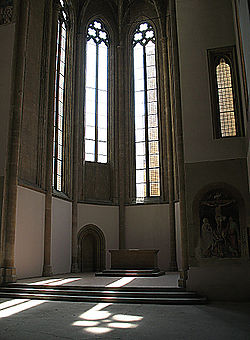
Santa Maria Donna Regina Vecchia
Encyclopedia

Naples
Naples is a city in Southern Italy, situated on the country's west coast by the Gulf of Naples. Lying between two notable volcanic regions, Mount Vesuvius and the Phlegraean Fields, it is the capital of the region of Campania and of the province of Naples...
, in southern Italy
Italy
Italy , officially the Italian Republic languages]] under the European Charter for Regional or Minority Languages. In each of these, Italy's official name is as follows:;;;;;;;;), is a unitary parliamentary republic in South-Central Europe. To the north it borders France, Switzerland, Austria and...
. It is called Vecchia ("old") to distinguish it from the newer and adjacent church of Santa Maria Donna Regina Nuova.
The earliest mention of a church on this site is from the year 780 in a reference to the nuns of the church of San Pietro del Monte di Donna Regina. At that time, the church was quite near the old eastern city wall. The nuns were of the Basilian
Basilian monk
Basilian monks are monks who follow the "Rule" of Saint Basil the Great, bishop of Caesarea. The chief importance of the monastic rules and institutes of St. Basil lies in the fact that to this day his reconstruction of the monastic life is the basis of most of the monasticism practiced in the...
order and, when that order left Naples in the beginning of the 9th century, took Benedictine
Benedictine
Benedictine refers to the spirituality and consecrated life in accordance with the Rule of St Benedict, written by Benedict of Nursia in the sixth century for the cenobitic communities he founded in central Italy. The most notable of these is Monte Cassino, the first monastery founded by Benedict...
vows. In 1264, Pope Gregory IX gave the nuns permission to join the Franciscan order.
In 1293 a severe earthquake caused great damage to the original structure, and queen Mary of Hungary
Mary of Hungary
Mary of Anjou was queen regnant of Hungary from 1382 until her death in 1395.-Childhood:...
, consort of the king of Naples, Charles II of Anjou financed the construction of a new complex adjacent to the old one. The newer complex is known as Santa Maria Donna Regina Nuova.
Overview
The interior has a nave with lumberLumber
Lumber or timber is wood in any of its stages from felling through readiness for use as structural material for construction, or wood pulp for paper production....
truss
Truss
In architecture and structural engineering, a truss is a structure comprising one or more triangular units constructed with straight members whose ends are connected at joints referred to as nodes. External forces and reactions to those forces are considered to act only at the nodes and result in...
es, according to the Franciscan style.
The main artwork in the interior is the sepulchre of Mary of Hungary, commissioned by his son Robert I of Anjou
Robert of Naples
Robert of Anjou , known as Robert the Wise was King of Naples, titular King of Jerusalem and Count of Provence and Forcalquier from 1309 to 1343, the central figure of Italian politics of his time. He was the third but eldest surviving son of King Charles II of Naples the Lame and Maria of Hungary...
from Tino da Camaino (who had been in Naples since 1324) and another Neapolitan artist. It is located in the left aisle and portrays the queen lying with a Franciscan habit, sustained by the four Virtues, with two Angels opening curtains to show her. The sarcophagus has four small niches with columns and agival arches containing statues of the queen's sons, including Charles Martel
Charles Martel of Anjou
Charles Martel of the Angevin dynasty, also known as Charles I Martel, was the eldest son of king Charles II of Naples and Maria of Hungary, the daughter of King Stephen V of Hungary....
, Louis of Toulouse
Louis of Toulouse
Saint Louis of Toulouse was a cadet of the royal French house of Anjou who was made a Catholic bishop. The California mission, city and county of San Luis Obispo, California, are named after him....
and Robert himself. It has also a decoration in azure mosaics.
Also notable are the 14th century frescoes by Pietro Cavallini
Pietro Cavallini
Pietro Cavallini was an Italian painter and mosaic designer working during the late Middle Ages. Little is known about his biography, though it is known he was from Rome, since he signed pictor romanus....
(along with his workshop, or some of his followers) and Filippo Rusuti, one of the most important pieces of paintings from that century in Naples. They were executed between 1307 and 1320 and depict, on two levels, stories of life of Christ and the Apostles. In the lower level are 17 episodes of Jesus, 5 of St. Elizabeth and four of St. Clare, paired to a Last Judgement, the latter certainly attributable to Cavallini. In the upper one are six scenes of St. Agnes. From the same period, but by unknown artists, are the Crucifixion frescoes on the left wall and the Annunciation on the wall facing the entrance.
The triumphal arch of the apse has two frescoes with the Crucifixion; the apse has remains of majolica
Maiolica
Maiolica is Italian tin-glazed pottery dating from the Renaissance. It is decorated in bright colours on a white background, frequently depicting historical and legendary scenes.-Name:...
-covered pavement from a Neapolitan workshop of the Angevine era (late 14th-early 15th century). Also present is a Martyrdom of St. Ursula attributed to Francesco da Tolentino (1520).

